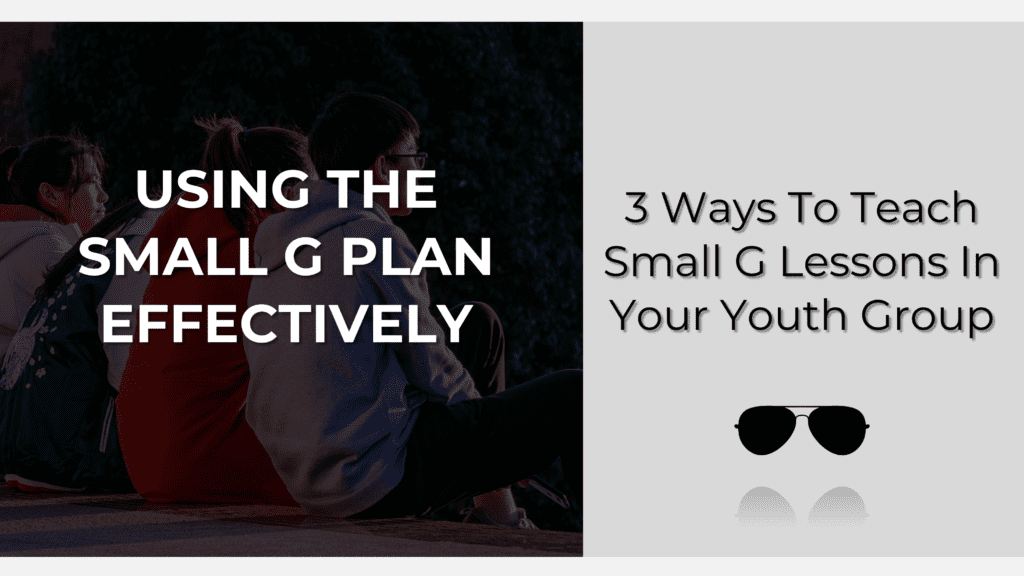
Why Theological Depth Matters in Youth Ministry Curriculum
There’s a common belief floating around church circles: that teenagers can’t handle deep theology. But, actually, they can. And they

I got involved in youth ministry, somewhat, by accident. There was no goal of vocational ministry, no seminary training, no intentional seeking of a job. Rather, there was a military move, a new church just getting its feet off the ground, and a group of students needing to be discipled. There was no man-made plan, but there was a prompting by the Holy Spirit. I wasn’t (yet) equipped, but I could almost tangibly feel the calling and placement being carved out before me. What’s a person to do, you know?
So, I stepped into the role, even though I didn’t know the answers to how it all was done. Next thing I knew, I was the full time Director of Student Ministry over a vibrant and overflowing ministry. But it started so small. Just a step of obedience into a place that I knew the Lord would, eventually, equip me. It was a simple “yes”, and suddenly life was full color (yet, totally crazy) and I had a front row seat to see unique works of God. I found myself asking the question “How do I lead a small youth group well?”.
I have a soft spot in my heart for churches and ministries who get to operate in the kind of intentional and personal focus that my first group of 5 students afforded. There is a richness of discipleship that happens in those contexts, in a very different way than can possibly take place in bigger spaces. So, if the group of students you are serving and leading seems small, be encouraged. Your small youth group is a big and beautiful calling.
Here at G Shades, we want to be a tool the Lord uses to equip you well in leading where He has led you. We want you to be able to effectively teach curriculum to your small youth group, and to feel confident about the plan being built for you. So, let’s talk about 3 different ways to teach Small G lessons.
We designed the Small G Plan with smaller churches in mind—pacing it intentionally and crafting it carefully to offer a solid, simple solution for gospel-centered youth ministry. That’s why, in addition to parent video resources and a year’s worth of youth ministry games, we equip you with five different lesson components with each Small G series. Let’s overview each of them briefly before we dive into 3 different ways to teach Small G lessons:
The Small Church Guide is your standard lesson guide for any small youth group. It takes a 15-minute sermon manuscript and retrofits it into an interactive 25-35-minute lesson perfect for a small youth group sitting in a circle. These lesson guides are typically comprised of short teaching monologues interspersed with gamified activities, discussion questions, and response time experiences.
Each Small Church Guide even includes an alternative lesson plan called Where Two or More Are Gathered. It’s designed for those nights when just one or two students show up. It’s the kind of guide I wish I’d had early on, when only one in five teens came and I still wanted to offer something meaningful. Just because it’s a small gathering doesn’t mean you throw out the plan or completely wing it. With the Small G Plan, you just adapt! Because where two or more are gathered in His name, He is there.
Every Small G series comes with full video messages for each lesson in the series. These video messages are engaging 10-15-minute sermons recorded by our amazing team of video communicators. So, pull up a seat alongside your crew and take in the content together!
Use these guides when you want to lead a focused discussion with your group—they come with every lesson. A Discussion Guide typically consists of 6-8 questions and an interactive activity designed to drive home the point of the lesson.
Every Small G series comes with a Discipleship Event. These event guides equip you to create an interactive response time experience for your students related to the content of the series you’re in.
These weekly three-day-devotional resources contain a passage, devotional thought, and space for students to journal. The devotionals are always related in content to the series they come with.
Without further ado, let’s talk through three ways to teach Small G lessons in your youth group.
One option is to use only the Small Church Guides to teach through the lesson at youth group. Play a game, share announcements, worship/pray, and then walk through the lesson plan with students. Afterward, hand each of them a printout copy of the Daily Devotionals, or, if you’re techier than me, digitally distribute the Daily Devotionals through a QR code on a screen or screenshots to a group text messaging platform.
With this option, you can use the Video Messages as a lesson prep resource or distribute them digitally so students who missed youth group can still hear a form of the lesson (what a WIN!).
For some of you, the beauty of having Video Messages is that you can do some, but not all, of the teaching. For those of you who prefer that kind of structure, you may decide to play the Video Message, and then use the activities, discussion questions, and reflections from the corresponding Small Church Guide to drive home the point of the sermon.
Others of you may play the previous lesson’s Video Message toward the beginning of youth group in order to recap. Doing so would provide you with a quick, engaging 10-minute recap shared by a fresh voice before you jump into the current lesson using the Small Church Guide!
For leaders who are short on time or capacity when you meet for youth group, this option is perfect. Just press play on the Video Message and watch the sermon with students. Then pull out the Discussion Guide afterward to facilitate a discussion based on what you all watched. You can even still get interactive with the one activity located at the bottom of each Discussion Guide!
Here’s a bonus tip as you’re learning to teach Small G lessons. Need more lessons than the quarterly series the Small G Plan provides? No problem! Consider spring boarding your Devotionals into their own lesson plan! It takes a little bit of leg work on your part, but here’s the beauty. Since each lesson of a series comes with three devotionals, you could easily turn a 4-lesson series into an 8-lesson series. Just use one devotional/week as a springboard into a new lesson!
In any event, no matter how you utilize the resources, the Small G Plan sets you up to succeed well. Your church matters, and your context matters. That’s why we’re creating some of the best and most flexible resources out there. We want to help you serve your congregation well. We want you to be able to teach Small G lessons with confidence and poise.
In the context of the gospel, God meets us where we are. We’re working hard to be the kind of company that does that for you. And we hope you’ll continue being the kind of youth leader who does that for your students.
Related Posts
Choosing The Best Youth Ministry Curriculum For Your Church
Youth Ministry Curriculum For Small Churches: Why A Different Approach Is Needed

There’s a common belief floating around church circles: that teenagers can’t handle deep theology. But, actually, they can. And they

If you’ve been around youth ministry for any amount of time, you know middle schoolers are in a totally unique

downtime, your students’ routines are totally different—and so is their connection to youth group. By the time August rolls around,